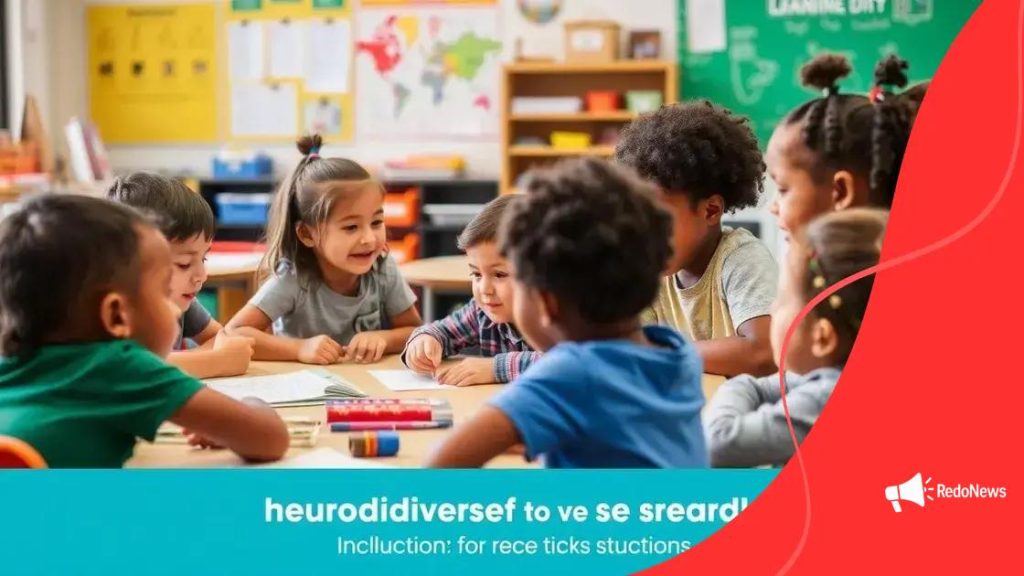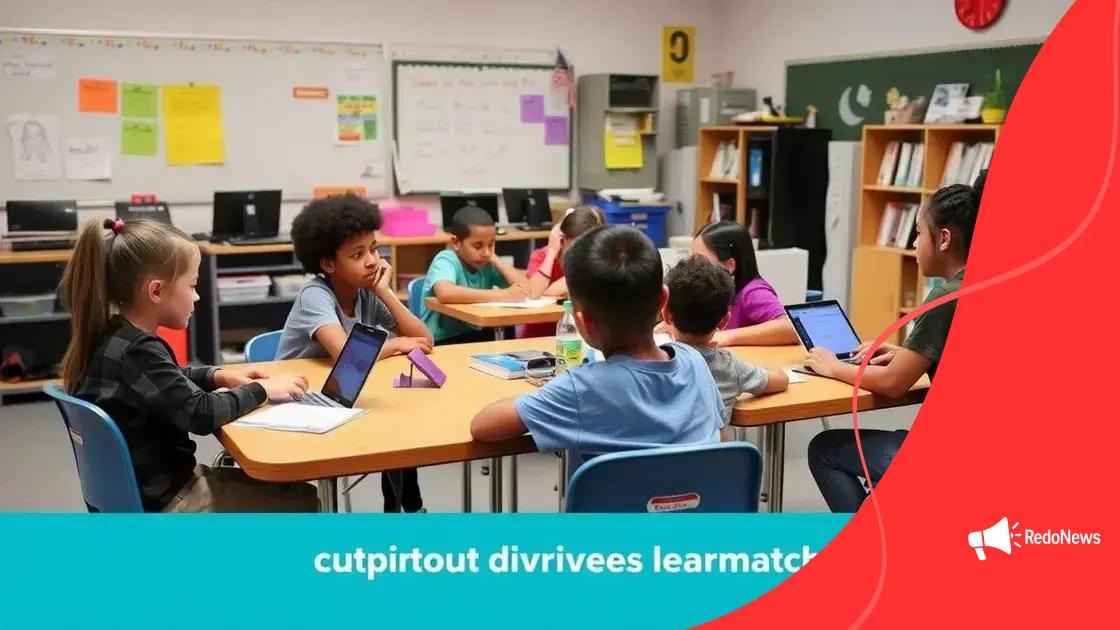Neurodiversity: Classroom focus on inclusive teaching

Supporting neurodiverse students involves collaboration with families and specialists, implementing personalized strategies, and integrating social-emotional learning to foster an inclusive educational environment.
Neurodiversity: Classroom focus is essential for creating inclusive learning environments. Have you ever considered how different minds contribute to our educational experiences? Let’s explore practical approaches together.
Understanding neurodiversity in education
Understanding neurodiversity in education is crucial for fostering an inclusive atmosphere in schools. Each student learns differently, and recognizing these variations can transform how educators approach teaching.
Defining Neurodiversity
Neurodiversity refers to the diversity of human brains and minds, embracing conditions like autism, ADHD, dyslexia, and others. It suggests that these differences should be respected and valued rather than viewed solely as deficits. This mindset promotes acceptance and understanding in educational settings.
The Importance of Acceptance
When students feel accepted, they are more likely to engage fully in their learning. An environment that embraces neurodiversity helps reduce anxiety and allows students to express themselves without fear of judgment.
- Builds self-esteem
- Encourages collaboration among peers
- Fosters creativity and innovation
Moreover, teaching practices that align with a neurodiverse perspective can enhance overall classroom dynamics. Strategies such as differentiation, where lessons are tailored to various learning styles, can benefit all students, not just those with specific needs.
Utilizing tools like visual aids or hands-on activities can aid understanding for all learners. Additionally, encouraging group activities helps students appreciate different perspectives and learn from one another, enriching the entire classroom experience.
- Promotes teamwork
- Enhances problem-solving skills
- Supports social development
Educators play a vital role in supporting neurodiverse learners. By creating a flexible curriculum that accommodates varied learning needs, they can ensure that every student has access to quality education. Professional development opportunities can equip teachers with the necessary skills to implement inclusive practices effectively.
Incorporating feedback from students and families can also guide improvements in teaching methods, creating a school culture that values every participant’s perspective.
Creating inclusive classroom environments
Creating inclusive classroom environments is essential for supporting diverse learners. These environments promote acceptance and help every student thrive. Schools can make significant changes to enhance inclusivity.
Designing the Space
A well-designed classroom can foster an inclusive atmosphere. Consider using flexible seating arrangements, which allow students to choose where and how they learn best. This setup caters to different needs, ensuring all students feel comfortable.
- Incorporate various seating options
- Create quiet zones for focused study
- Use bright, engaging visuals
Classroom decor should reflect diversity as well. It’s important to celebrate various cultures and perspectives through posters, artwork, and literature. This representation helps students feel valued and seen.
Implementing Flexible Teaching Strategies
Inclusive classrooms use diverse teaching methods to meet different learning styles. These strategies should adjust based on students’ unique needs to ensure everyone can participate.
For instance, using both visual aids and hands-on activities can help students understand complex concepts better. This variety keeps learning engaging and supports retention.
- Utilize technology for interactive lessons
- Encourage group work for peer support
- Provide options for assignments and assessments
Moreover, fostering open communication is crucial. Encourage students to express their thoughts and feelings in a safe space. Establishing ground rules for respectful discussions helps everyone feel comfortable sharing.
Collaborative projects can further enhance teamwork and build relationships among students. This interaction boosts social skills and encourages empathy, vital for an inclusive environment.
Additionally, regular feedback from students can guide improvements in teaching approaches. Listening to their experiences helps create an atmosphere that meets everyone’s needs.
Strategies for teaching neurodiverse students

Strategies for teaching neurodiverse students are essential for creating an effective learning environment. Each student brings unique traits and learning preferences, making it vital for teachers to adapt their methods.
Utilizing Differentiated Instruction
Differentiated instruction allows teachers to cater to various learning styles within the classroom. By offering different approaches to learning, all students can engage in meaningful ways. For instance, some may benefit from visual presentations, while others thrive with hands-on activities.
- Use visual aids to enhance understanding
- Incorporate technology like tablets or interactive whiteboards
- Provide options for project formats (e.g., video, poster, presentation)
This flexibility encourages students to express their knowledge in ways that suit them best, fostering a more inclusive experience.
Encouraging Collaboration and Peer Support
Creating opportunities for collaboration is another effective strategy. Group work helps neurodiverse students learn from their peers and develop social skills. It is crucial to establish roles within groups to ensure that every student can contribute meaningfully.
Teachers should facilitate these interactions by guiding discussions and promoting teamwork. This support helps build a sense of community where students can feel safe and valued.
- Assign roles to students in group activities
- Encourage sharing of ideas and perspectives
- Foster an environment of respect and encouragement
Another key to teaching neurodiverse students is providing clear and consistent routines. Predictability can reduce anxiety and help students focus on learning. Simple visual schedules can support this by outlining daily activities so students know what to expect.
Providing feedback promptly is also essential. Regular check-ins and constructive feedback can guide students in their learning journeys. This ongoing dialogue fosters resilience and motivation.
Lastly, recognizing the importance of social-emotional learning can help students manage their feelings and build strong interpersonal skills. Integrating activities that promote empathy and emotional awareness enhances overall educational experiences.
Supporting social-emotional learning
Supporting social-emotional learning (SEL) is vital for all students, especially for those who are neurodiverse. SEL helps students understand and manage their emotions, set positive goals, and establish healthy relationships. By integrating SEL into daily lessons, teachers can create a nurturing environment for everyone.
Integrating SEL into the Classroom
Incorporating SEL activities into the classroom is an effective way to promote emotional awareness. Activities like morning check-ins allow students to express how they feel at the start of each day. This practice helps establish a routine where emotions are acknowledged and discussed openly.
- Use role-playing scenarios to practice empathy
- Introduce calming techniques like deep breathing
- Encourage journaling for self-reflection
These strategies foster an understanding of emotions and teach students how to respond to challenges constructively.
Building a Supportive Community
Creating a safe and supportive community is essential for effective social-emotional learning. Students should feel secure when expressing their feelings. Implementing class agreements that emphasize respect and kindness is a great first step.
Teachers can also provide positive reinforcement to promote collaboration and teamwork. For instance, highlighting acts of kindness encourages students to support one another.
- Recognize student achievements regularly
- Encourage peer mentoring to foster relationships
- Organize group projects that require teamwork
Furthermore, connecting families to SEL initiatives creates a cohesive support system. Providing resources for families can help them support their children’s emotional growth at home.
Regular family workshops focused on SEL topics can strengthen this connection and ensure a unified approach to emotional and social skills development. When families understand the importance of SEL, they can reinforce these principles in daily life.
Lastly, continuous training for teachers on SEL practices is vital. Professional development can equip educators with the tools they need to address social-emotional challenges effectively. This ongoing learning allows teachers to implement new strategies and adapt to the diverse needs of their students.
Collaboration with families and specialists
Collaboration with families and specialists is essential for supporting neurodiverse students effectively. These partnerships create a stronger support network that benefits students in various ways. Teachers who engage with families and specialists can better understand their students’ needs.
Engaging Families
Involving families in the educational process fosters a sense of community and shared responsibility. Regular communication is vital for understanding each child’s unique background and challenges. Teachers can organize meetings or workshops to share strategies and resources with families.
- Schedule regular parent-teacher conferences
- Create newsletters to keep families informed
- Encourage parental input on learning strategies
By establishing a two-way communication system, families can feel empowered and involved in their child’s education. This involvement can also help in reinforcing learning at home.
Working with Specialists
Collaboration with specialists such as psychologists, speech therapists, and special education teachers enhances the educational experience for neurodiverse students. These professionals bring expertise that can guide teachers in crafting appropriate instructional strategies. Regular consultations with specialists can provide insights into the best practices for supporting individual students.
Team meetings with specialists allow teachers to discuss specific challenges and brainstorm solutions. These collaborations may lead to tailored interventions that address the needs of each student effectively.
- Develop individualized education plans (IEPs)
- Share student progress and strategies with specialists
- Utilize specialist resources for classroom support
Furthermore, including specialists in training sessions for teachers can enhance their skills in addressing diverse learning needs. This ongoing professional development helps educators stay informed about new strategies and resources.
Lastly, creating a network that connects families with specialists is beneficial. Organizing workshops or informational sessions helps parents understand available resources and how to access them. This knowledge empowers families to seek help and advocate for their children effectively.
FAQ – Questions about supporting neurodiverse students
What is neurodiversity?
Neurodiversity refers to the natural variation in human brains and minds, including conditions like autism, ADHD, and dyslexia.
How can teachers involve families in education?
Teachers can involve families by maintaining open communication, organizing regular meetings, and providing resources to support learning at home.
Why is collaboration with specialists important?
Collaboration with specialists ensures that educators can customize teaching strategies to meet the unique needs of neurodiverse students effectively.
What role does social-emotional learning play?
Social-emotional learning helps students manage their emotions, develop empathy, and build strong relationships, supporting their overall educational experience.
